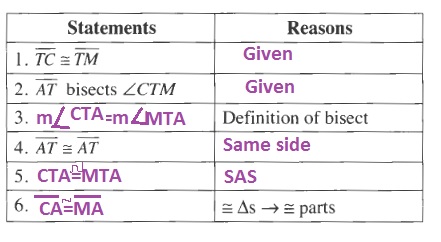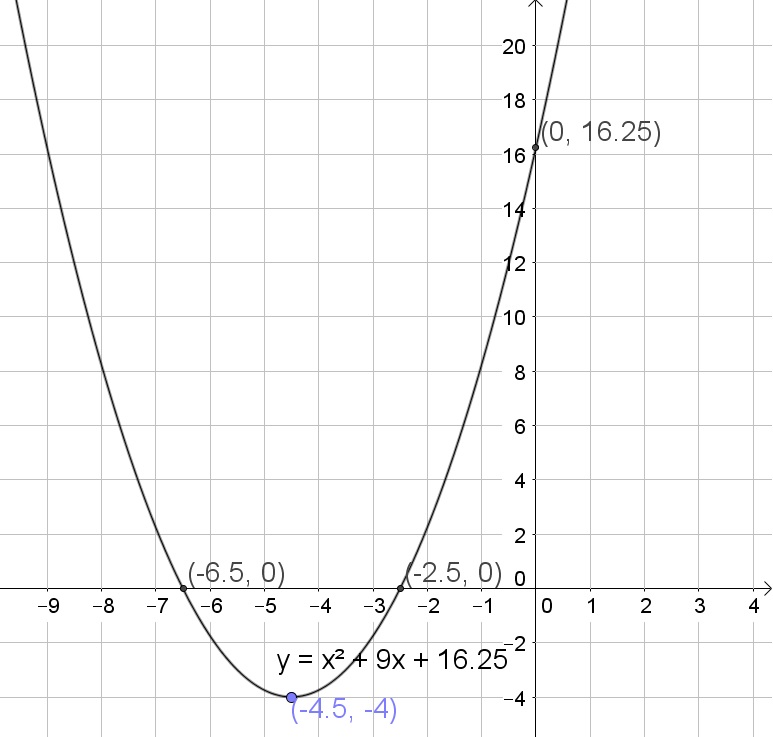All Solutions
Page 423: Closure Activity

b. Given
c. $mangle CTA=mangle MTA$
d. Same size
5. SAS
6. $overline{CA}cong overline{MA}$
$$
cos{42text{textdegree}}=dfrac{x}{10}
$$
Multiply both sides of the equation by 10:
$$
7.4approx 10cos{42text{textdegree}}=x
$$
Since the sum of all angles in a triangle is 180$text{textdegree}$, we can then determine the top angle in the triangle:
$$
180text{textdegree}-45text{textdegree}-45text{textdegree}=90text{textdegree}
$$
Since the top angle is 90$text{textdegree}$, we then know that the triangle is a right triangle.
The sine ratio is the opposite side divided by the hypotenuse:
$$
sin{45text{textdegree}}=dfrac{x}{15}
$$
The sine of 45$text{textdegree}$ is $dfrac{sqrt{2}}{2}$:
$$
dfrac{sqrt{2}}{2}=dfrac{x}{15}
$$
Multiply both sides of the equation by 15:
$$
10.6066approx dfrac{15sqrt{2}}{2}=x
$$
$$
theta=sin^{-1}dfrac{10}{18}approx 34text{textdegree}
$$
b. $x=frac{15sqrt{2}}{2}approx 10.6066$
c. $theta approx 34text{textdegree}$
$$
sqrt{9}sqrt[3]{27}x^2y^{1-1}
$$
Simplify:
$$
3cdot 3x^2y^0
$$
Simplify:
$$
9x^2
$$
$$
(x^{1/2})^{-2}=x^{1/2(-2)}=x^{-1}=dfrac{1}{x}
$$
$$
dfrac{1^{2/3}}{125^{2/3}}
$$
Rewrite rational exponent as root:
$$
dfrac{1}{(sqrt[3]{125})^2}
$$
Evaluate root:
$$
dfrac{1}{5^2}
$$
Simplify:
$$
dfrac{1}{25}
$$
$$
dfrac{8}{-2}x^{3+2}
$$
Simplify:
$$
-4x^5
$$
b. $frac{1}{x}$
c. $frac{1}{25}$
d. $-4x^5$
$$
18% cdot dfrac{27000-7776-6750-6750}{27000}=18%cdot dfrac{5724}{27000}=0.18cdot 0.212=0.03816=3.816%
$$
b. Yes, because 18% of every class is in the performing arts.
c. Because of independency:
$$
begin{align*}
P(SENIOR given PERFORMANCE)&=P(senior)
\ &=dfrac{27000-7776-6750-6750}{27000}
\ &=dfrac{5724}{27000}
\ &=0.212
\ &=21.2%
end{align*}
$$
b. Yes
c. 21.2%
$$
x^2-x-56=(x-8)(x+7)
$$
$$
3x^2-4x+1=(3x-1)(x-1)
$$
$$
2x^3+x^2+x=x(2x^2+x+1)
$$
$$
2x^2-50=2(x^2-25)
$$
Factorize the difference of squares ($a^2-b^2=(a-b)(a+b)$):
$$
2x^2-50=2(x-5)(x+5)
$$
b. $(3x-1)(x-1)$
c. $x(2x^2+x+1)$
d. $2(x-5)(x+5)$
$$
x=dfrac{1pm sqrt{(-1)^2-4(2)(-5)}}{2(2)}=dfrac{1pm sqrt{41}}{4}
$$
Thus we note that the answers are irrational.
$$
0=-4x^2+4x-1
$$
Factorize:
$$
0=(2x-1)^2
$$
Take the square root of both sides of the equation:
$$
0=2x-1
$$
Add 1 to both sides of the equation:
$$
1=2x
$$
Divide both sides of the equation by 2:
$$
dfrac{1}{2}=x
$$
Thus the answers are rational.
b. $x=frac{1}{2}$, Rational
$$
0=x^2+9x+16.25
$$
Add 4 to both sides of the equation:
$$
4=x^2+9x+20.25
$$
Factorize:
$$
4=(x+4.5)^2
$$
Take the square root of both sides of the equation:
$$
pm 2 = x+4.5
$$
Subtract 4.5 from both sides of the equation:
$$
-2.5text{ or }-6.5=-4.5pm 2=x
$$
Thus the $x$-intercepts are $x=-2.5$ and $x=-6.5$, the $y$-intercepts is the constant term of the equation thus $y=16.25$. The vertex finally is $(-4.5,-4)$.

$y$-intercept: $(0,16.25)$
Vertex $(-4.5,-4)$
$$
2x+50=3x+25
$$
Subtract $2x$ from both sides of the equation:
$$
50=x+25
$$
Subtract 25 from both sides of the equation:
$$
25=x
$$
$$
5t+1+2t+5+t+3t-2=202
$$
Combine like terms:
$$
11t+4=202
$$
Subtract 4 from both sides of the equation:
$$
11t=198
$$
Divide both sides of the equation by 11:
$$
t=18
$$
$$
4x-2=90
$$
Add 2 to both sides of the equation:
$$
4x=92
$$
Divide both sides of the equation by 4:
$$
x=23
$$
$$
13m-9=7m+15
$$
Subtract $7m$ from both sides of the equation:
$$
6m-9=15
$$
Add 9 to both sides of the equation:
$$
6m=24
$$
Divide both sides of the equation by 6:
$$
m=4
$$
b. $t=18$
c. $x=23text{textdegree}$
d. $m=4$

